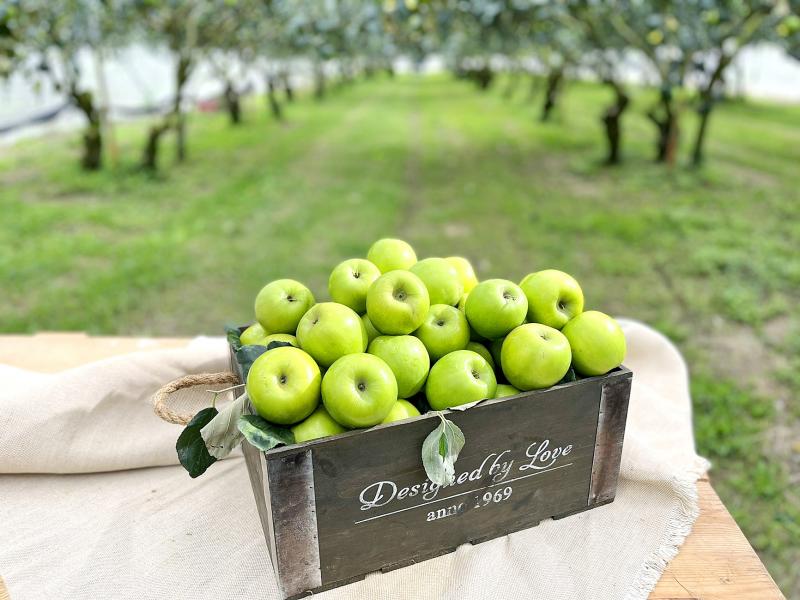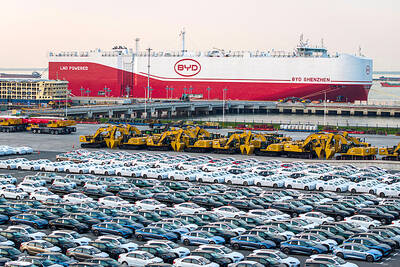Green jujubes grown in Kaohsiung are scheduled to hit supermarket shelves in France today as part of the city’s efforts to introduce the fruit to consumers in Europe, the Kaohsiung City Government Agriculture Bureau said yesterday.
Kaohsiung green jujubes are already sold in Hong Kong, Japan, Malaysia, Palau and Singapore, the bureau said.
The city is the largest green jujube producer in Taiwan, with a growing area of 750 hectares that makes up more than 40 percent of the country’s total for jujubes.

Photo courtesy of Kaohsiung City Government’s Agriculture Bureau
Farms growing the fruit are mainly found in Alian (阿蓮), Dashe (大社), Gangshan (岡山), Tianliao (田寮) and Yanchao (燕巢) districts, the bureau said.
The annual production value of Kaohsiung green jujubes has averaged NT$1 billion (US$35.87 million) in the past few years, the bureau said, adding that it intensified its efforts to boost visibility in the global market after exporting 870,897 tonnes of the fruit last year.
Kaohsiung is selling batches of the Tainung No. 13 green jujube — also known as the “Shirley” (雪麗) — to France through a trader in the Netherlands, the bureau said, describing the Shirley green jujube as having a perfect balance between sweet and sour flavors.
The green jujubes first arrived in the Netherlands by air and were then transported via road to France, it said, adding that the entire delivery process involved advanced cold chain storage so that consumers in France could enjoy fresh green jujubes like those sold in Taiwan.
The bureau worked with the Taiwan Agricultural Research Institute under the Council of Agriculture to ensure that the fruit traveled well.
In addition to the Shirley, Kaohsiung has also sold Kaohsiung No. 11 Zhenmi (珍蜜) green jujubes overseas.
The bureau said people in Taiwan can log on to the Best of Kaohsiung e-commerce platform to order green jujubes into next month.

Micron Memory Taiwan Co (台灣美光), a subsidiary of US memorychip maker Micron Technology Inc, has been granted a NT$4.7 billion (US$149.5 million) subsidy under the Ministry of Economic Affairs A+ Corporate Innovation and R&D Enhancement program, the ministry said yesterday. The US memorychip maker’s program aims to back the development of high-performance and high-bandwidth memory chips with a total budget of NT$11.75 billion, the ministry said. Aside from the government funding, Micron is to inject the remaining investment of NT$7.06 billion as the company applied to participate the government’s Global Innovation Partnership Program to deepen technology cooperation, a ministry official told the

Taiwan Semiconductor Manufacturing Co (TSMC, 台積電), the world’s leading advanced chipmaker, officially began volume production of its 2-nanometer chips in the fourth quarter of this year, according to a recent update on the company’s Web site. The low-key announcement confirms that TSMC, the go-to chipmaker for artificial intelligence (AI) hardware providers Nvidia Corp and iPhone maker Apple Inc, met its original roadmap for the next-generation technology. Production is currently centered at Fab 22 in Kaohsiung, utilizing the company’s first-generation nanosheet transistor technology. The new architecture achieves “full-node strides in performance and power consumption,” TSMC said. The company described the 2nm process as

Shares in Taiwan closed at a new high yesterday, the first trading day of the new year, as contract chipmaker Taiwan Semiconductor Manufacturing Co (TSMC, 台積電) continued to break records amid an artificial intelligence (AI) boom, dealers said. The TAIEX closed up 386.21 points, or 1.33 percent, at 29,349.81, with turnover totaling NT$648.844 billion (US$20.65 billion). “Judging from a stronger Taiwan dollar against the US dollar, I think foreign institutional investors returned from the holidays and brought funds into the local market,” Concord Securities Co (康和證券) analyst Kerry Huang (黃志祺) said. “Foreign investors just rebuilt their positions with TSMC as their top target,

POTENTIAL demand: Tesla’s chance of reclaiming its leadership in EVs seems uncertain, but breakthrough in full self-driving could help boost sales, an analyst said Chinese auto giant BYD Co (比亞迪) is poised to surpass Tesla Inc as the world’s biggest electric vehicle (EV) company in annual sales. The two groups are expected to soon publish their final figures for this year, and based on sales data so far this year, there is almost no chance the US company led by CEO Elon Musk would retain its leadership position. As of the end of last month, BYD, which also produces hybrid vehicles, had sold 2.07 million EVs. Tesla, for its part, had sold 1.22 million by the end of September. Tesla’s September figures included a one-time boost in